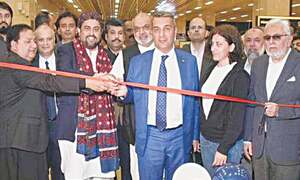The signing of an agreement with the Chinese for construction of four 660MW power plants at Gadani has come at a time when Pakistan’s three major cities — Lahore, Peshawar and Quetta — have been declared by the World Health Organisation to be among the 10 most polluted cities in the year 2011.
In fact, the 2014 Environmental Performance Index ranks Pakistan at 148 among 178 countries, and 127 in terms of human health from environmental damage and air quality. Today, Karachi, with a pollution index of 96.42, is the seventh worst among 261 cities of the world.
While the country faces serious environmental challenges, the government has embarked upon an ambitious plan to meet future electricity needs through coal-based power generation, which would add to environmental degradation.
Handling, storage and burning of coal in large quantities will result in huge emissions of air pollutants. Several coal-fired power plants, of cumulative capacity of over 23,000MW, are planned to be constructed within few years.
The Pakistan Power Park at Gadani envisages establishing 10 units of combined capacity of 10,660MW on imported coal. China signed an agreement on March 18 for construction of four units each of 660MW, and has committed to set up another two units of same capacity in the second phase.
Earlier, a UAE company signed a MoU on March 5 for two units of 1,320MW total capacity at Gadani. The Asian Development Bank signed an agreement on February 13 to finance the imported coal-based Jamshoro Coal Power project of 1,200MW. Recently, a Letter of Interest has been issued to a Qatar-China joint venture for establishing 1320 MW coal-based power plants at Port Qasim, Karachi.
Simultaneously, the development of indigenous coal resources for power generation has been launched. Construction of the first phase of the 1,200MW integrated mining-cum-power generation project at Thar was inaugurated on January 31.
Meanwhile, Punjab plans to construct power plants of 6,000MW cumulative capacity at six locations — Sahiwal, Sheikhupura, Jhang, Kasur, Rahim Yar Khan and Muzaffargarh — with the help of the private sector. The provincial government has already signed an agreement with the Chinese for coal exploration and development.
Plans are also underway to convert existing oil-based thermal power plants to coal. This month, K-Electric (formerly KESC) awarded a contract to a Chinese company to convert two units (420 MW) of the Bin Qasim power station. K-Electric is also setting up a greenfield coal power plant of 660MW capacity.
Hubco has decided to establish a 600MW power plant based on imported coal, while conversion of its existing furnace oil-based plant is also under consideration.
Gradually, more oil-based plants, like Lalpir Power and PakGen Power in Muzaffargarh, and Saba Power at Sheikhupura, will be converted to coal. In addition, a number of small coal-based power plants in the range of 25-50MW each of the cement industry, industrial estates and other organisations are either in operation or in the pipeline.
Yearly consumption of coal by a 600MW power plant is around 1.8 million tonnes, depending on its quality, which amounts to about 5,000 tonnes per day. Currently, Karachi port handles two million tonnes coal annually, primarily to meet the cement industry’s requirements.
Consequently, Karachi port facilities are being upgraded to increase its capability to import coal in larger quantities. A coal cargo terminal able to handle 4-8 million tonnes of coal annually in the first phase is being constructed at Port Qasim.
Logistics will also require a complete supply-chain of thousands of trucks and hundreds of railway wagons every day for transporting coal to proposed power plants in different parts of the country, except for the Gadani complex, which will have a dedicated jetty for coal handling.
The total incremental concentration of conventional and hazardous pollutants of the planned power stations will be a major source of carbon dioxide emission and effluents, and affect air quality and water resources, with an adverse impact on human and marine life and wildlife. All these projects have been launched without conducting environmental impact assessment, a pre-requisite under the law.
Some emissions can be significantly reduced with the adoption of mitigation measures, like carbon capture and storage, and the application of advanced combustion technology.
Employing state-of-the-art, highly efficient and low-carbon advanced technology, developed and deployed in the USA, Germany, Denmark, South Korea and Japan, is highly critical. China has also established a few power plants that are based on Western ultra-supercritical technology.
The writer is a former chairman of the State Engineering Corporation















































